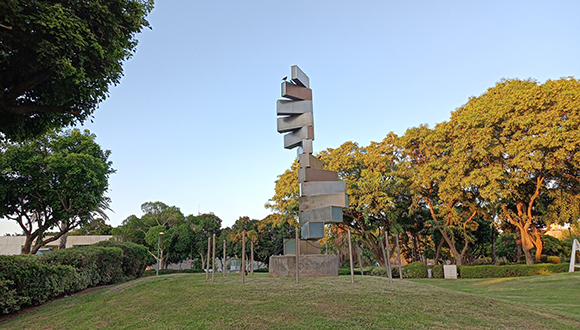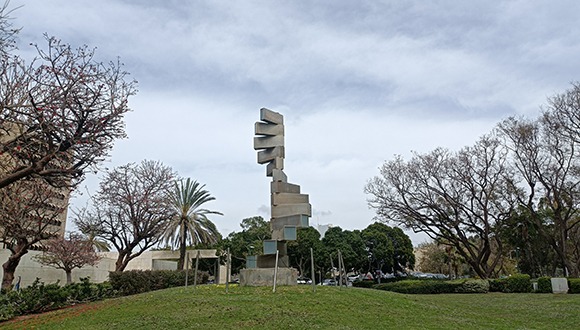Light Spiral | Theo & Ora Coster, David Argaman
"Light Spiral," in memory of Bracha Ramot, reflects her scientific curiosity, determination, and passion for research. Its location symbolizes her contributions to medical science.
About the Work and the Creator / Einat Abramson
Light Spiral (2009) towers to a height of five meters. It is made of 13 identical rectangular cuboids laid one on top of the other to form a shape reminiscent of a spiraling staircase or a sky-scraping DNA molecule. The cuboids are hollow, with one side blocked by frosted glass, and contain 150-Watt bulbs whose light traces the sculpture's spiral shape even when it is dark.
The sculpture is the product of a collaborative process by its originators and donors Theo and Ora Coster, and sculptor David Argaman. Born in Holland, Theo Coster managed to escape the Nazis as a child by being sheltered by a Dutch family. In his autobiographic book We All Wore Stars, he describes a peaceful childhood and a proud member of the boys' "pilots club". In his spare time, he would build airplane models from available raw materials such as oak and beech wood and cotton cloth.
He immigrated to Israel in 1955 and met his partner Ora, and together they started a product design company called Theora. The monumental sculpture commemorates Professor Bracha Ramot (1927-2006), a hematology researcher and friend of the Costers.

The spiral, a shape common in art and design throughout history, has been reinterpreted by two artistic currents of the 20th century: constructivism and minimalism. Light Spiral is clearly influenced by both. First, it evokes the model for the Monument to the Third International (1919-20) by Vladimir Tatlin, a Russian artist and architect and a leader of the constructivist movement.
This spiral structure - commonly called Tatlin's Tower - was planned to be 400 meters high and serve as a tower based on a cubic conference hall. The monument, which was never built, is composed of three geometric parts designed to move in different speeds. It embodies the constructivist ideal of combining abstract art and industrial and architectural aesthetics using construction materials such as iron, steel and glass, and designing the building's shape in keeping with its designated function.
Well-Organized Composition
Light Spiral also has a geometric shape of regular and well-organized composition, and it too is made of an industrial material - stainless steel - and reveals the welding marks of the different sections. Creating "clean" and emotion-free sculpting, the constructivists have argued that it is precisely the exposed material and composition that would stir the observer’s feelings.
The recurring cubic shapes in Argaman and the Costers' sculpture is also reminiscent of the ideas of minimalism, as represented for example in Donald Judd’s work. Judd's sculptures are also characterized by formal serialism, and he states that their parts are all interchangeable since they are completely identical.

Eternal Passion for Research
Light Spiral represents Bracha Ramot's character: her scientific curiosity and her determination and passion for study and research. The artists' decision to locate the sculpture between the Sackler Faculty of Medicine and the George S. Wise Faculty of Life Sciences also stands for Ramot's contribution to medicalscientific research. The use of stainless steel is designed to give it a quality of perpetuity combined with the sense of elevation generated by the pure DNA like single helix shape, with the cuboids symbolizing nucleotides. At night, the sculpture is lighted like a memorial candle, commemorating Ramot’s eternal passion for research.
There are many DNA-shaped outdoor sculptures worldwide. One is The Cell and DNA (2002-3) at Maggie's Cancer Caring Center in Glasgow, planned by landscape researcher and architect Charles Jencks. The helix in this sculpture stands on a small hill surrounded by a green fence next to the building, adjacent to another cell-shaped part.
The sculpture is made of aluminum and creates a blinding flash effect when it reflects natural light. The two sculptures, Argaman and the Costers' and Jencks' use a shared language in terms of their industrial raw material, shape and the changing nature of the object depending on the observer's location.
Argaman and the Costers have collaborated on several outdoor sculptures. One of them is Momentum (2016) in Holon's industrial zone, made up of 12 identical cubes that create a Star-of-David shape.
| Artist: | |
| Theo & Ora Coster | David Argaman | |
| Name: | |
| Light Spiral, 2009 | |
| Location: | |
| On a knoll on the lawn between the Webb School of Languages and the Sherman Building of Life Sciences. | |
| Donated by the artists in memory of Professor Bracha Ramot |





